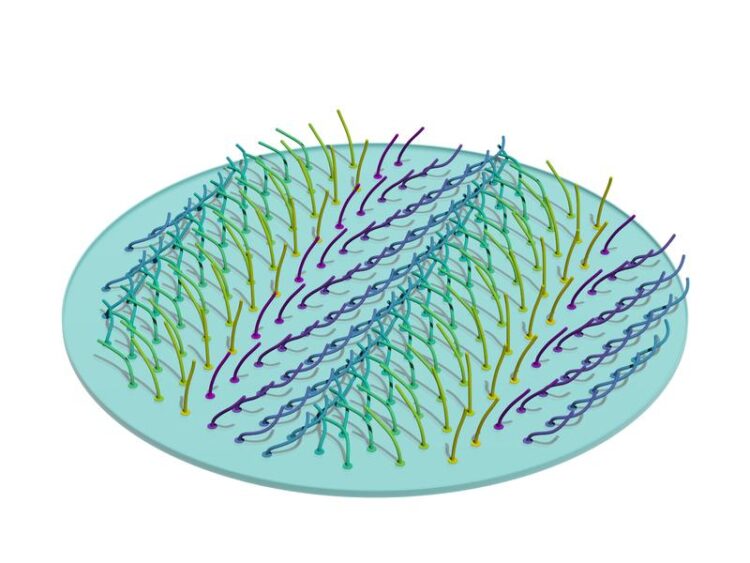Order from a border

The coordinated beating pattern of cilia is driven by non-reciprocal interactions and the border regions, as described in a new model.
(C) MPI-DS/ LMP
Edges cause cilia to quickly synchronize their beating pattern.
Border regions can cause cilia to coordinate their motion creating a unidirectional wave that is essential for biological functions. Scientists from the Max Planck Institute for Dynamics and Self-Organization (MPI-DS) in Göttingen proposed a new model describing this synchronized pattern driven by the border region.
What do the crowd at a football stadium, the feet of a centipede, and the inside of your lungs have in common? All of these systems show the same specific kind of organization, as it was recently found by the scientists. The Mexican wave in a stadium looks like a pattern traveling across the tiers. Similarly, the legs of a centipede move in canon with illusory waves sweeping along its entire length. On a microscopic level, tiny hairs in our lungs called cilia wave together to transport mucus. This serves as a first line of defense against invading pathogens.
Unequal interactions between cilia cause synchronization
To create a synchronized and efficient wave, cilia need to accurately coordinate their beating motion. Unlike football fans watching their neighbors and the nervous system coordinating the centipede’s legs, cilia have no such intelligent control system.
In their new study, the scientists David Hickey, Ramin Golestanian and Andrej Vilfan from the department Living Matter Physics at MPI-DS now highlight the importance or border regions for the coordination of cilia. “When many cilia beat closely together, they can synchronize by beating slightly before their neighbors to one side, and slightly after their neighbors to the other – just like a Mexican wave in a stadium”, says David Hickey, first author of the study. This synchronization is mediated by the fluid surrounding the cilia and initiated by the border region. Notably, two cilia beating near each other don’t necessarily exert the same force to each other. Depending on its position, a cilium can be more effected by its neighbor than vice versa, especially in a dense carpet of cilia as it frequently occurs in nature. This can eventually cause a directed, non-reciprocal pattern forming a wave.
Synchronization of cilia is initiated by border regions
“The cilia at a border region take the role as a pacemaker which entrain other cilia one after another”, Hickey summarizes the findings. “This observation is different from previous models where boundaries were assumed to perturb the order”, he continues. This view was also shared by the renowned physicist Wolfgang Pauli who joked about this: “God made solids, but surfaces were the work of the devil.”
As found now, border regions of surfaces can in fact allow a better understanding of the self-organization of living matter. At the same time, the model reveals striking similarities between mechanisms in the microscopic world and on the macroscopic scale.
Originalpublikation:
https://www.pnas.org/doi/10.1073/pnas.2307279120
Weitere Informationen:
Media Contact
All latest news from the category: Life Sciences and Chemistry
Articles and reports from the Life Sciences and chemistry area deal with applied and basic research into modern biology, chemistry and human medicine.
Valuable information can be found on a range of life sciences fields including bacteriology, biochemistry, bionics, bioinformatics, biophysics, biotechnology, genetics, geobotany, human biology, marine biology, microbiology, molecular biology, cellular biology, zoology, bioinorganic chemistry, microchemistry and environmental chemistry.
Newest articles

Detector for continuously monitoring toxic gases
The material could be made as a thin coating to analyze air quality in industrial or home settings over time. Most systems used to detect toxic gases in industrial or…

On the way for an active agent against hepatitis E
In order to infect an organ, viruses need the help of the host cells. “An effective approach is therefore to identify targets in the host that can be manipulated by…

A second chance for new antibiotic agent
Significant attempts 20 years ago… The study focused on the protein peptide deformylase (PDF). Involved in protein maturation processes in cells, PDF is essential for the survival of bacteria. However,…





















